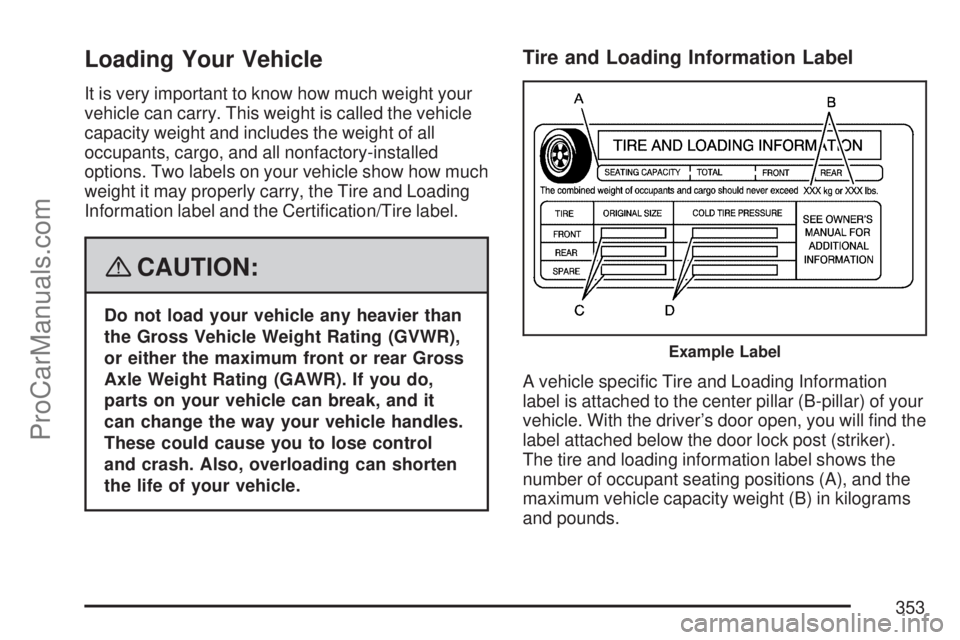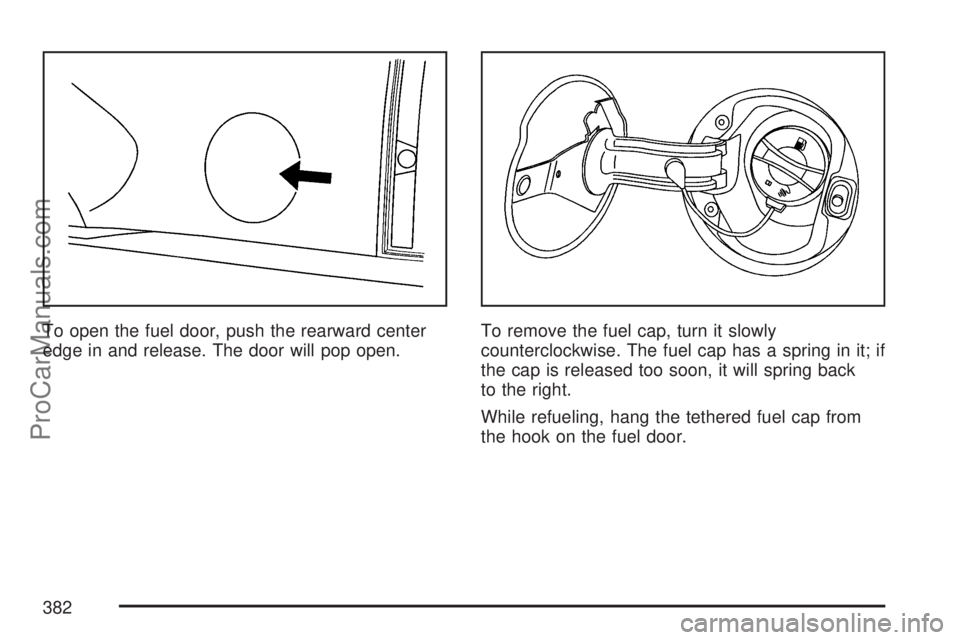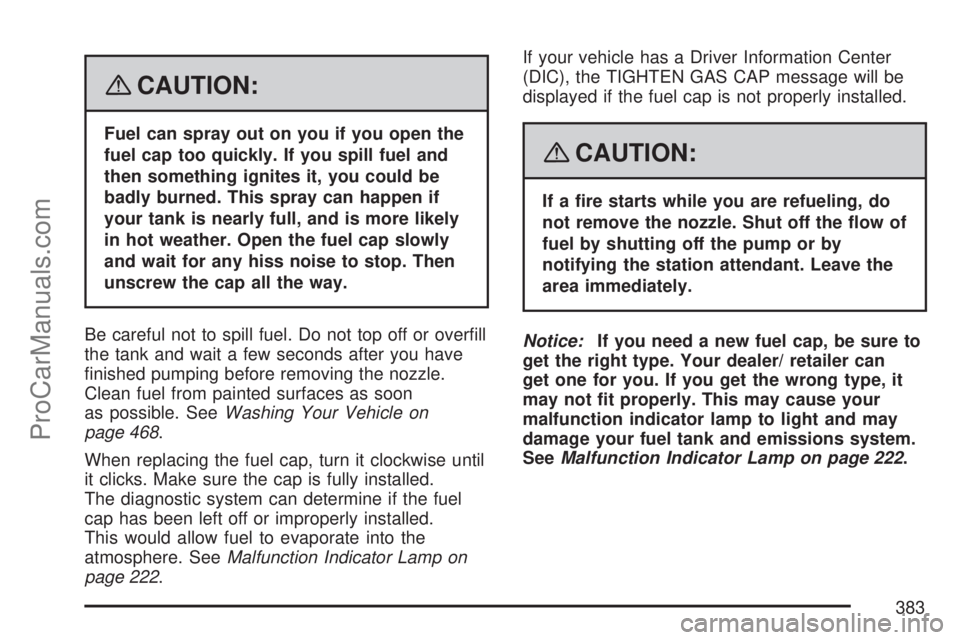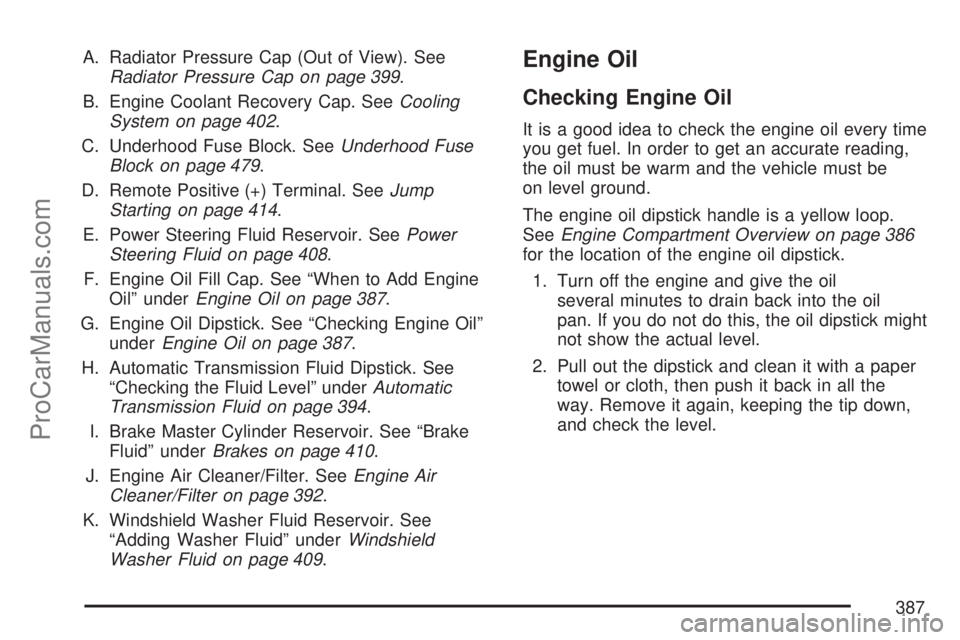lock SATURN OUTLOOK 2007 Owners Manual
[x] Cancel search | Manufacturer: SATURN, Model Year: 2007, Model line: OUTLOOK, Model: SATURN OUTLOOK 2007Pages: 538, PDF Size: 3.2 MB
Page 351 of 538

{CAUTION:
Snow can trap exhaust gases under your
vehicle. This can cause deadly CO
(carbon monoxide) gas to get inside. CO
could overcome you and kill you. You
cannot see it or smell it, so you might not
know it is in your vehicle. Clear away
snow from around the base of your
vehicle, especially any that is blocking the
exhaust pipe. And check around again
from time to time to be sure snow does
not collect there.
Open a window just a little on the side of
the vehicle that is away from the wind.
This will help keep CO out.Run the engine only as long as you must. This
saves fuel. When you run the engine, make it go a
little faster than just idle. That is, push the
accelerator slightly. This uses less fuel for the
heat that you get and it keeps the battery charged.
You will need a well-charged battery to restart
the vehicle, and possibly for signaling later on with
the headlamps. Let the heater run for a while.
Then, shut the engine off and close the window
almost all the way to preserve the heat. Start
the engine again and repeat this only when you
feel really uncomfortable from the cold. But do it as
little as possible. Preserve the fuel as long as
you can. To help keep warm, you can get out of
the vehicle and do some fairly vigorous exercises
every half hour or so until help comes.
351
ProCarManuals.com
Page 353 of 538

Loading Your Vehicle
It is very important to know how much weight your
vehicle can carry. This weight is called the vehicle
capacity weight and includes the weight of all
occupants, cargo, and all nonfactory-installed
options. Two labels on your vehicle show how much
weight it may properly carry, the Tire and Loading
Information label and the Certi�cation/Tire label.
{CAUTION:
Do not load your vehicle any heavier than
the Gross Vehicle Weight Rating (GVWR),
or either the maximum front or rear Gross
Axle Weight Rating (GAWR). If you do,
parts on your vehicle can break, and it
can change the way your vehicle handles.
These could cause you to lose control
and crash. Also, overloading can shorten
the life of your vehicle.
Tire and Loading Information Label
A vehicle speci�c Tire and Loading Information
label is attached to the center pillar (B-pillar) of your
vehicle. With the driver’s door open, you will �nd the
label attached below the door lock post (striker).
The tire and loading information label shows the
number of occupant seating positions (A), and the
maximum vehicle capacity weight (B) in kilograms
and pounds.
Example Label
353
ProCarManuals.com
Page 359 of 538

Dinghy Towing
If you have a front-wheel-drive vehicle, it can be
dinghy towed from the front. These vehicles
may also be towed by putting the front wheels on
a dolly. See “Dolly Towing” later in this section.
If you have an all-wheel-drive vehicle, it can
be dinghy towed from the front. You can also tow
these vehicles by placing them on a platform
trailer with all four wheels off of the ground. These
vehicles cannot be towed using a dolly.
For vehicles being dinghy towed, the vehicle
should be run at the beginning of each day and at
each RV fuel stop for about �ve minutes. This
will ensure proper lubrication of transmission
components. Put the IGN (Ignition) fuse in to start
the vehicle.To tow your vehicle from the front with all four
wheels on the ground:
1. Position the vehicle to tow and then secure it.
2. Turn the ignition to OFF.
3. Set the parking brake.
4. To prevent your battery from draining while
the vehicle is being towed, remove the IGN
(Ignition) fuse from the underhood fuse block.
SeeUnderhood Fuse Block on page 479.
5. Turn the ignition to ACCESSORY.
359
ProCarManuals.com
Page 369 of 538

Hitches
It’s important to have the correct hitch equipment.
Crosswinds, large trucks going by and rough
roads are a few reasons why you’ll need the right
hitch. Here are some rules to follow:
The rear bumper on your vehicle is not
intended for hitches. Do not attach rental
hitches or other bumper-type hitches to it. Use
only a frame-mounted hitch that does not
attach to the bumper.
Will you have to make any holes in the body
of your vehicle when you install a trailer
hitch? If you do, then be sure to seal the holes
later when you remove the hitch. If you
don’t seal them, deadly carbon monoxide (CO)
from your exhaust can get into your vehicle.
SeeEngine Exhaust on page 137. Dirt
and water can, too.
Safety Chains
You should always attach chains between your
vehicle and your trailer. Cross the safety chains
under the tongue of the trailer so that the tongue will
not drop to the road if it becomes separated from
the hitch. Instructions about safety chains may be
provided by the hitch manufacturer or by the trailer
manufacturer. Follow the manufacturer’s
recommendation for attaching safety chains and do
not attach them to the bumper. Always leave just
enough slack so you can turn with your rig. And,
never allow safety chains to drag on the ground.
Trailer Brakes
If you tow more than 1,000 lbs (450 kg), use trailer
brakes. Because your vehicle has anti-lock
brakes, don’t try to tap into your vehicle’s hydraulic
brake system. If you do, both brake systems
won’t work well, or at all.
Be sure to read and follow the instructions for the
trailer brakes so you’ll be able to install, adjust
and maintain them properly.
369
ProCarManuals.com
Page 376 of 538

Buying New Tires...................................... 440
Different Size Tires and Wheels................ 442
Uniform Tire Quality Grading..................... 442
Wheel Alignment and Tire Balance............ 444
Wheel Replacement.................................. 444
Tire Chains............................................... 445
If a Tire Goes Flat.................................... 446
Changing a Flat Tire................................. 447
Removing the Spare Tire and Tools.......... 448
Removing the Flat Tire and Installing
the Spare Tire....................................... 451
Secondary Latch System........................... 456
Storing a Flat or Spare Tire and Tools...... 459
Compact Spare Tire.................................. 463
Appearance Care........................................ 464
Cleaning the Inside of Your Vehicle.......... 464
Fabric/Carpet............................................. 465
Leather...................................................... 466
Instrument Panel, Vinyl, and Other
Plastic Surfaces..................................... 467
Care of Safety Belts.................................. 467
Weatherstrips............................................ 467
Washing Your Vehicle............................... 468
Cleaning Exterior Lamps/Lenses................ 468Finish Care............................................... 468
Windshield, Backglass, and
Wiper Blades.......................................... 469
Aluminum or Chrome-Plated
Wheels and Trim................................... 470
Tires......................................................... 471
Sheet Metal Damage................................. 471
Finish Damage.......................................... 471
Underbody Maintenance............................ 472
Chemical Paint Spotting............................ 472
Vehicle Care/Appearance Materials............ 473
Vehicle Identi�cation.................................. 474
Vehicle Identi�cation Number (VIN)........... 474
Service Parts Identi�cation Label............... 474
Electrical System........................................ 475
High Voltage Devices and Wiring.............. 475
Add-On Electrical Equipment..................... 475
Windshield Wiper Fuses............................ 475
Power Windows and Other
Power Options....................................... 476
Fuses and Circuit Breakers....................... 476
Instrument Panel Fuse Block..................... 476
Underhood Fuse Block.............................. 479
Capacities and Speci�cations.................... 483
Section 5 Service and Appearance Care
376
ProCarManuals.com
Page 377 of 538

Service
Your dealer/retailer knows your vehicle best and
wants you to be happy with it. We hope you will go
to your dealer/retailer for all your service needs.
You will get genuine Saturn parts and
Saturn-trained and supported service people.
We hope you will want to keep your Saturn vehicle
all Saturn. Genuine Saturn parts have one of
these marks.
Accessories and Modi�cations
When you add non-Saturn accessories to your
vehicle they can affect your vehicle’s performance
and safety, including such things as, airbags,
braking, stability, ride and handling, emissions
systems, aerodynamics, durability, and electronic
systems like anti-lock brakes, traction control,
and stability control. Some of these accessories
may even cause malfunction or damage not
covered by warranty.
Saturn accessories are designed to complement
and function with other systems on your vehicle.
Your Saturn retailer can accessorize your vehicle
using genuine Saturn accessories. When you go to
your Saturn retailer and ask for Saturn accessories,
you will know that Saturn-trained and supported
service technicians will perform the work using
genuine Saturn accessories.
377
ProCarManuals.com
Page 382 of 538

To open the fuel door, push the rearward center
edge in and release. The door will pop open.To remove the fuel cap, turn it slowly
counterclockwise. The fuel cap has a spring in it; if
the cap is released too soon, it will spring back
to the right.
While refueling, hang the tethered fuel cap from
the hook on the fuel door.
382
ProCarManuals.com
Page 383 of 538

{CAUTION:
Fuel can spray out on you if you open the
fuel cap too quickly. If you spill fuel and
then something ignites it, you could be
badly burned. This spray can happen if
your tank is nearly full, and is more likely
in hot weather. Open the fuel cap slowly
and wait for any hiss noise to stop. Then
unscrew the cap all the way.
Be careful not to spill fuel. Do not top off or over�ll
the tank and wait a few seconds after you have
�nished pumping before removing the nozzle.
Clean fuel from painted surfaces as soon
as possible. SeeWashing Your Vehicle on
page 468.
When replacing the fuel cap, turn it clockwise until
it clicks. Make sure the cap is fully installed.
The diagnostic system can determine if the fuel
cap has been left off or improperly installed.
This would allow fuel to evaporate into the
atmosphere. SeeMalfunction Indicator Lamp on
page 222.If your vehicle has a Driver Information Center
(DIC), the TIGHTEN GAS CAP message will be
displayed if the fuel cap is not properly installed.
{CAUTION:
If a �re starts while you are refueling, do
not remove the nozzle. Shut off the �ow of
fuel by shutting off the pump or by
notifying the station attendant. Leave the
area immediately.
Notice:If you need a new fuel cap, be sure to
get the right type. Your dealer/ retailer can
get one for you. If you get the wrong type, it
may not �t properly. This may cause your
malfunction indicator lamp to light and may
damage your fuel tank and emissions system.
SeeMalfunction Indicator Lamp on page 222.
383
ProCarManuals.com
Page 387 of 538

A. Radiator Pressure Cap (Out of View). See
Radiator Pressure Cap on page 399.
B. Engine Coolant Recovery Cap. SeeCooling
System on page 402.
C. Underhood Fuse Block. SeeUnderhood Fuse
Block on page 479.
D. Remote Positive (+) Terminal. SeeJump
Starting on page 414.
E. Power Steering Fluid Reservoir. SeePower
Steering Fluid on page 408.
F. Engine Oil Fill Cap. See “When to Add Engine
Oil” underEngine Oil on page 387.
G. Engine Oil Dipstick. See “Checking Engine Oil”
underEngine Oil on page 387.
H. Automatic Transmission Fluid Dipstick. See
“Checking the Fluid Level” underAutomatic
Transmission Fluid on page 394.
I. Brake Master Cylinder Reservoir. See “Brake
Fluid” underBrakes on page 410.
J. Engine Air Cleaner/Filter. SeeEngine Air
Cleaner/Filter on page 392.
K. Windshield Washer Fluid Reservoir. See
“Adding Washer Fluid” underWindshield
Washer Fluid on page 409.Engine Oil
Checking Engine Oil
It is a good idea to check the engine oil every time
you get fuel. In order to get an accurate reading,
the oil must be warm and the vehicle must be
on level ground.
The engine oil dipstick handle is a yellow loop.
SeeEngine Compartment Overview on page 386
for the location of the engine oil dipstick.
1. Turn off the engine and give the oil
several minutes to drain back into the oil
pan. If you do not do this, the oil dipstick might
not show the actual level.
2. Pull out the dipstick and clean it with a paper
towel or cloth, then push it back in all the
way. Remove it again, keeping the tip down,
and check the level.
387
ProCarManuals.com
Page 395 of 538

Checking the Fluid Level
Prepare the vehicle as follows:
1. Park the vehicle on a level place. Keep the
engine running.
2. With the parking brake applied, place the shift
lever in PARK (P).
3. With your foot on the brake pedal, move the
shift lever through each gear, pausing for
about three seconds in each one. Then,
position the shift lever in PARK (P).
4. Let the engine run at idle for three to
�ve minutes.
Then, without shutting off the engine, follow these
steps:
The transmission �uid
dipstick cap has this
symbol on it, and
is located near the front
of the engine
compartment.SeeEngine Compartment Overview on page 386
for more information on location.
1. Remove the dipstick and wipe it with a clean
rag or paper towel.
2. Reinstall back in all the way, wait
three seconds and then pull it back out
again.
3. Check both sides of the dipstick, and read the
lower level. The �uid level must be in the
crosshatched area.
4. If the �uid level is in the acceptable range,
twist & lock dipstick cap in place.
395
ProCarManuals.com